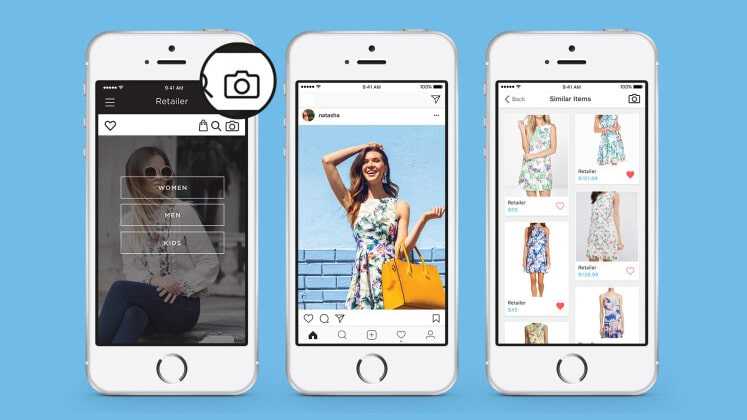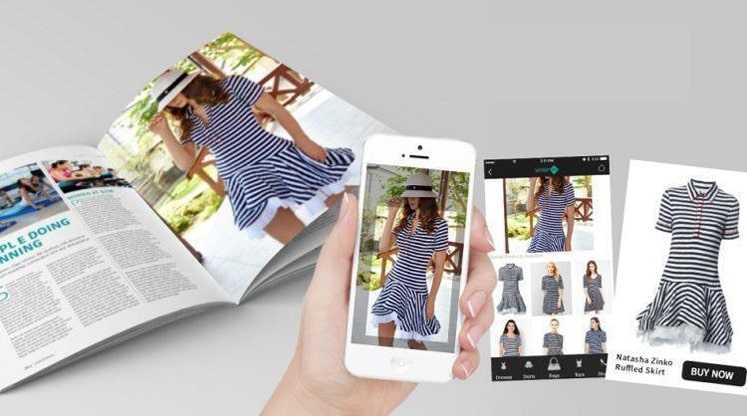
Visual search uses real world images such as screenshots, internet images, or photographs to search for a product online. Advanced-level visual search platforms use Artificial Intelligence (AI) to understand the images and show similar results. A shopper, for example, can simply click a photo of the product they want, use it to inform their search, and generate an immediate result of all the similar products available. The search method can help them instantly find the correct product they are looking for and cut down the time searching for the right keywords.
The technology is based on the same theory of how humans identify objects. When looking at a picture, humans do not see points and dotted lines, but instead see patterns and shapes. Visual search works on the same concept. The algorithms are trained to perform the same function. When presented with an image, visual search identifies an object and then performs a search operation to look for similar objects. For example, on an image of a red dress, the technology looks for other similar options of red dresses.
Visual search is powered by deep learning (a subset of AI and machine learning) which uses neural networks to constantly learn and understand users. Companies with huge amount of data gain the most benefits with visual search. For example, Google Lens can improve its search functionality using the abundant data it has. Moreover, it cannot just identify objects in an image, but can also match them to local retailers, provide customer reviews, and sort listings.
The apparel retailers realising the benefits from visual search has already started experimenting with the technology a long time ago. Amazon launched StyleSnap, an AI-based visual search tool that helps customers find products using an image. The tool is integrated in the Amazon app. Customers can use it by clicking the camera on the right hand corner of the app, selecting the StyleSnap option, and then uploading a photo or screenshot of the products they’re looking for. The tool then gives similar suggestions considering factors like brand, price range, and customer review. What makes this search engine smart is its power to train with millions of data, enabling it to intelligently differentiate between products.
Moreover, the visual search tool is a great help for fashion lovers, as it allows the customers to search for an outfit they found while randomly scrolling through their social media feeds. Earlier, it would have been difficult to search for a similar outfit as the customer would not find the correct keyword to describe. The tool is breaking that barrier.
In addition, Deloitte estimated the Image Recognition Market will grow to almost $ 39 billion by 2021. Gartner also revealed that by 2021, early adopter brands that redesign their websites to support visual and voice search can expect a 30 per cent increase in digital commerce revenue.
Syte delivers search results with accuracy of 95 per cent
The limitations of textual search lead to the founding of the company Syte. As one day, Lihi Pinto Fryman , one of Syte’s co-founders, was browsing through social media. She spotted a beautiful red dress, but had no next step to purchase it other than making a feeble attempt by typing ‘red dress’ on Google. The inability to accurately describe the attributes of the dress inspired the idea of a Visual AI solution and started the Syte Journey.
“The ability to search with images instead of text is rapidly becoming not only a channel consumers tap into to seamlessly find products, but also a strategy retailers use to smoothen the buying journey,” shared Lihi.
Syte, based in Israel, is the leading provider of Visual AI solutions. Its suite of solutions includes Camera Search, Deep Tagging, Next Generation Textual Search, Recommendation Engines, In-Store Smart Mirrors and Tablets. The company’s AI-powered Camera Search, “is a Visual AI solution that makes every picture, screenshot, or real-world image instantly shoppable from within a retailer’s inventory. Shoppers can simply upload an image onto a retailer’s website or app to immediately browse and buy the most visually similar items available. Camera Search simplifies product discovery, bridges the gap from inspiration to purchase, and eliminates the barriers of textual search,” said Lihi.
The Camera Search technology uses multi-object detection which makes the tool smart enough to detect multiple objects in a single image upload. This further simplifies the search process for the customers, as they do not have to crop the image in order to make their search much more specific. They can select the product they want from the image and can get relevant search options, delivering the most frictionless shopping experience. The tool is also trained with millions of data that further narrows down the search to gender, age, brand, and logo detection.
As the solution leverages the use of breakthrough technology, it assures retailers of a search result accuracy of about 95 per cent. The technology is powered by five years of computer vision research and development in European Organisation for Nuclear Research (CERN) labs. Having delivered this century’s biggest physics discovery, the Higgs boson particle, the Syte team spent an additional four years perfecting the content-based image retrieval (CBIR) technology and transitioning it to the world of retail.

“We have been extensively benchmarked by the world’s largest companies such as Microsoft and Samsung, and repeatedly selected as best in class. Syte’s visual search technology has 95 per cent accuracy which is 2X-6X more accurate compared to any similar technology,” said Lihi.
The tools are trained with the retailers’ catalogue, so that they deliver the most appropriate search results from the inventory. The technology is super easy for retailers to use, as they simply need to sync their catalogue using a ‘Product Feed’ which is basically a CSV file. Moreover, the technology implementation involves minimal to no IT setup. It starts with importing of inventory. Retailers have to set up auto export of their catalogue then the AI indexes it within 24 hours while it syncs live. After this, the dashboards are designed as per the requirement of the customers. Moreover, retailers can choose either to build a user interface or build their own using the API/SDK.
What makes the search result relevant is that the tool leverages 10,000 attributes and values, and breaks down an image into its minute style details for accurate meta-tagging.
Furthermore, as part of its future journey, the company is also working on ways to improve the offerings to the customers. The company recently rolled out a new feature to Syte’s Visual AI platform called the ‘Discovery Icon’, creating a Pinterest style navigation that makes any image on a website automatically shoppable. Syte’s AI algorithms analyse the image, identify all products, and within seconds show similar results. Shoppers then find the items that match exactly what they are looking for. For retailers, it is proven to improve Customer Retention and Engagement with a conversion uplift of around 52 per cent. In addition, by allowing customers to view similar items and ‘shop the look’, retailers can personalise the experience and monitor for out of stock items to significantly reduce bounce rates.
The company is also working with the ‘Next Generation Textual Search Feature’ that introduces an improved textual search experience on e-commerce websites. Textual Search leverages Syte’s Deep Tagging, AI search technology, and bespoke lexicon of 10,000+ fashion and design attributes. It uses consistent and in-season tags to automatically process images and enable shoppers to seamlessly refine their search.
Syte includes leading retailers in its customer portfolio such as Boohoo, PrettyLittleThing, Farfetch, and Venca. Boohoo experienced an increase of 85 per cent in its conversion rate for customers who used visual search. The retailer also saw a 125 per cent increase in its page visits per session for camera search as mentioned on its website.
“Consumers today are demanding more out of the customer experience. Identifying their ever-evolving needs and offering proactive solutions – at a faster pace – is the new norm. With AI, retailers have exciting, engaging new ways to win and retain consumers.” highlighted Lihi.
“As the technology matures, AI will help retailers deliver an even better and more seamless omnichannel experience with IoT; enhance search with visual, conversational, and guided product discovery; and offer adaptive, device-responsive, and dynamic outreach. Combining AI with a customer-centric strategy is a strong foundation as the retail revolution advances,” concluded Lihi.

Post a Comment